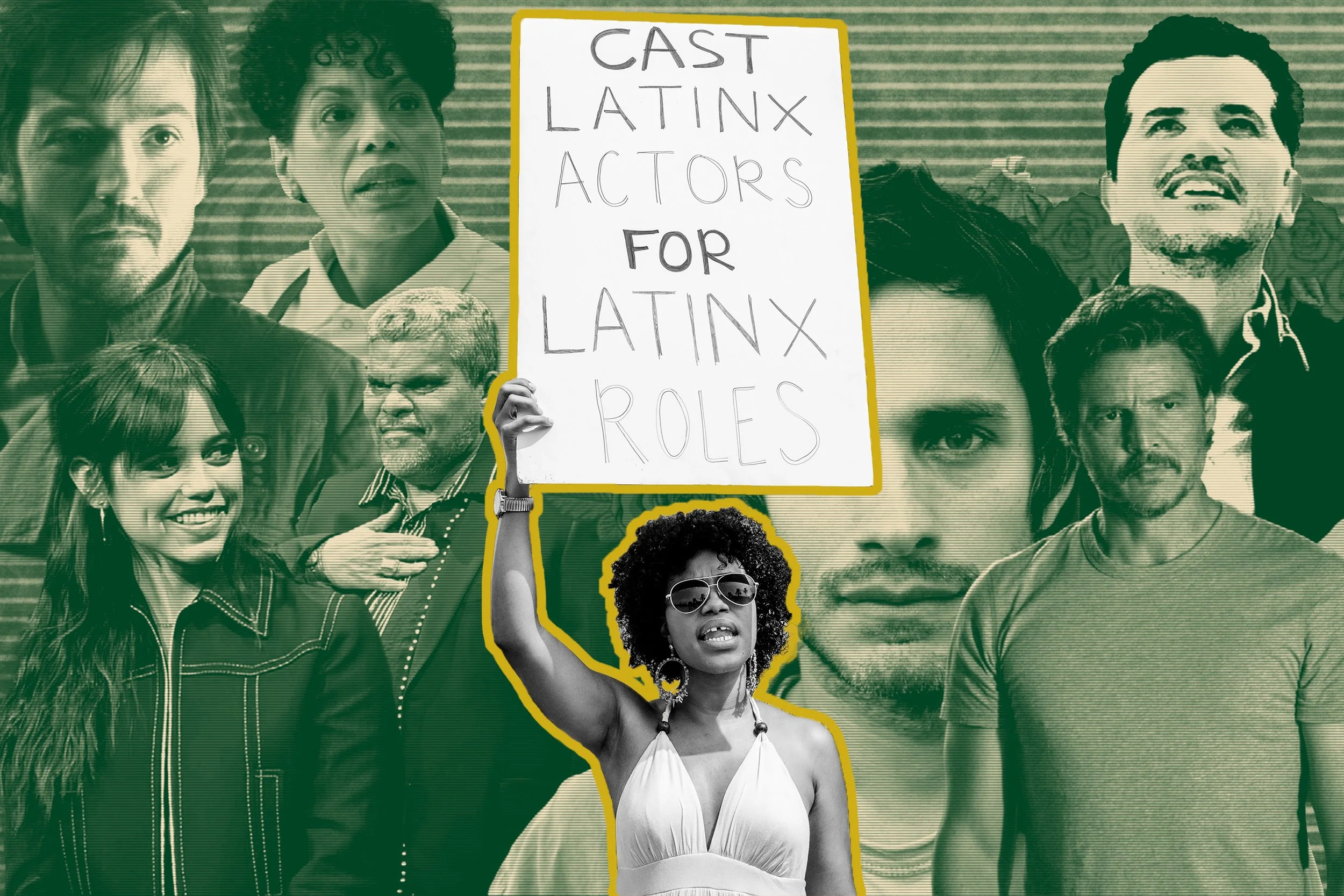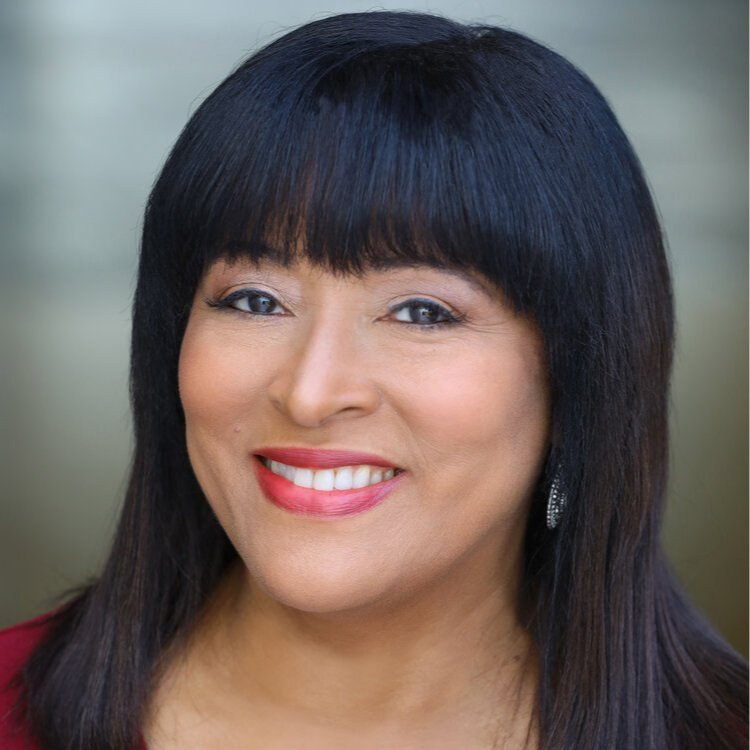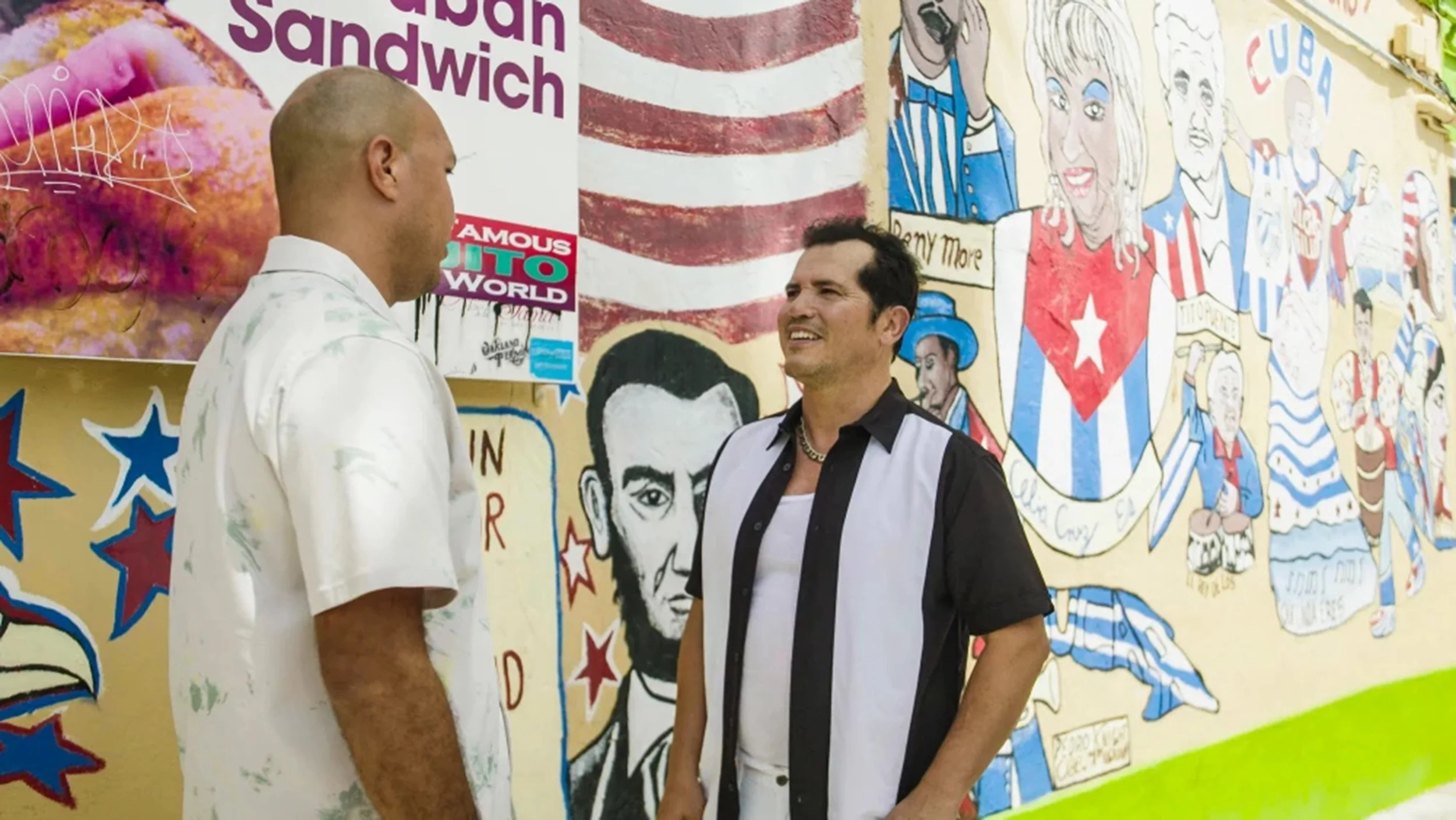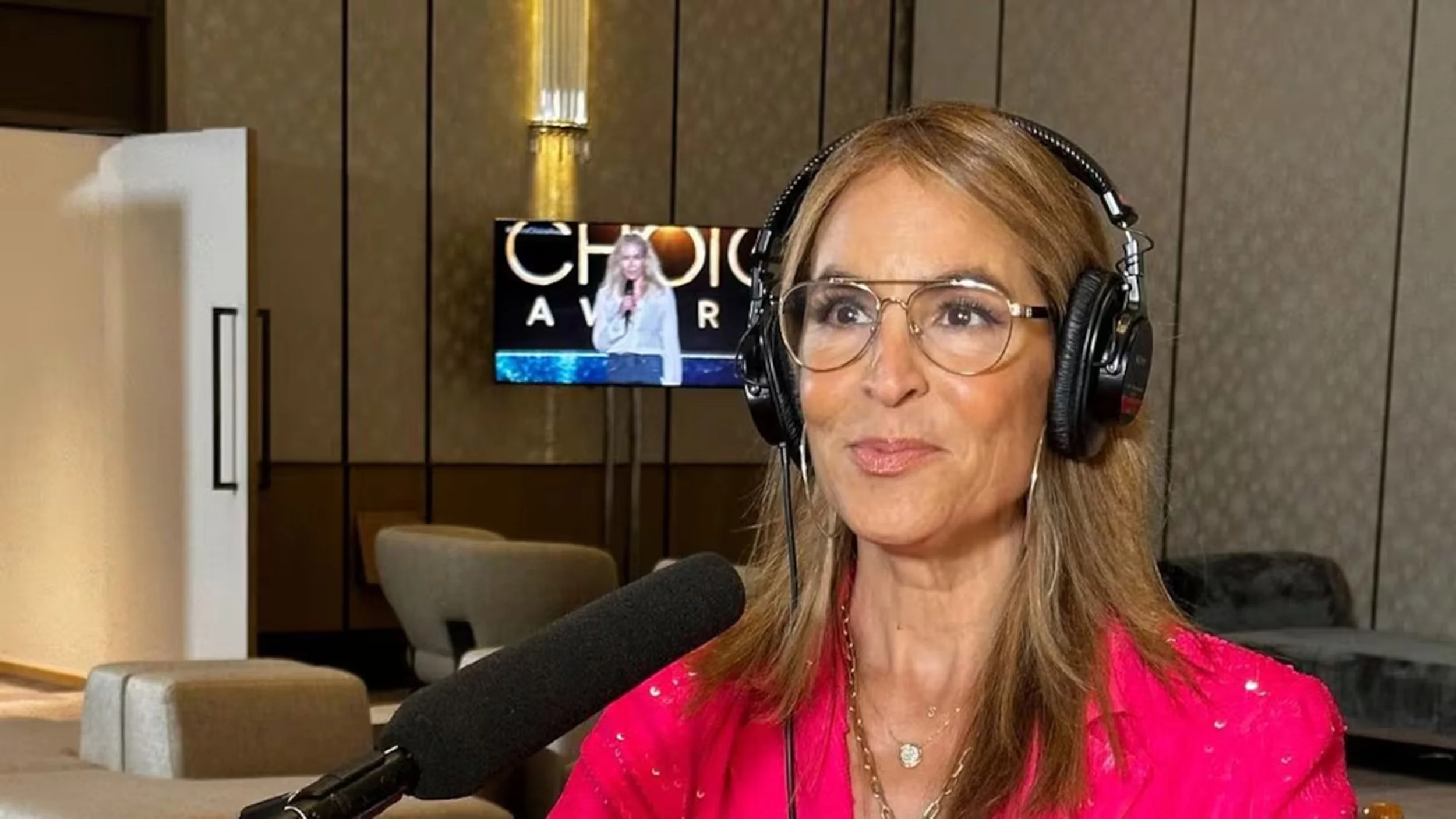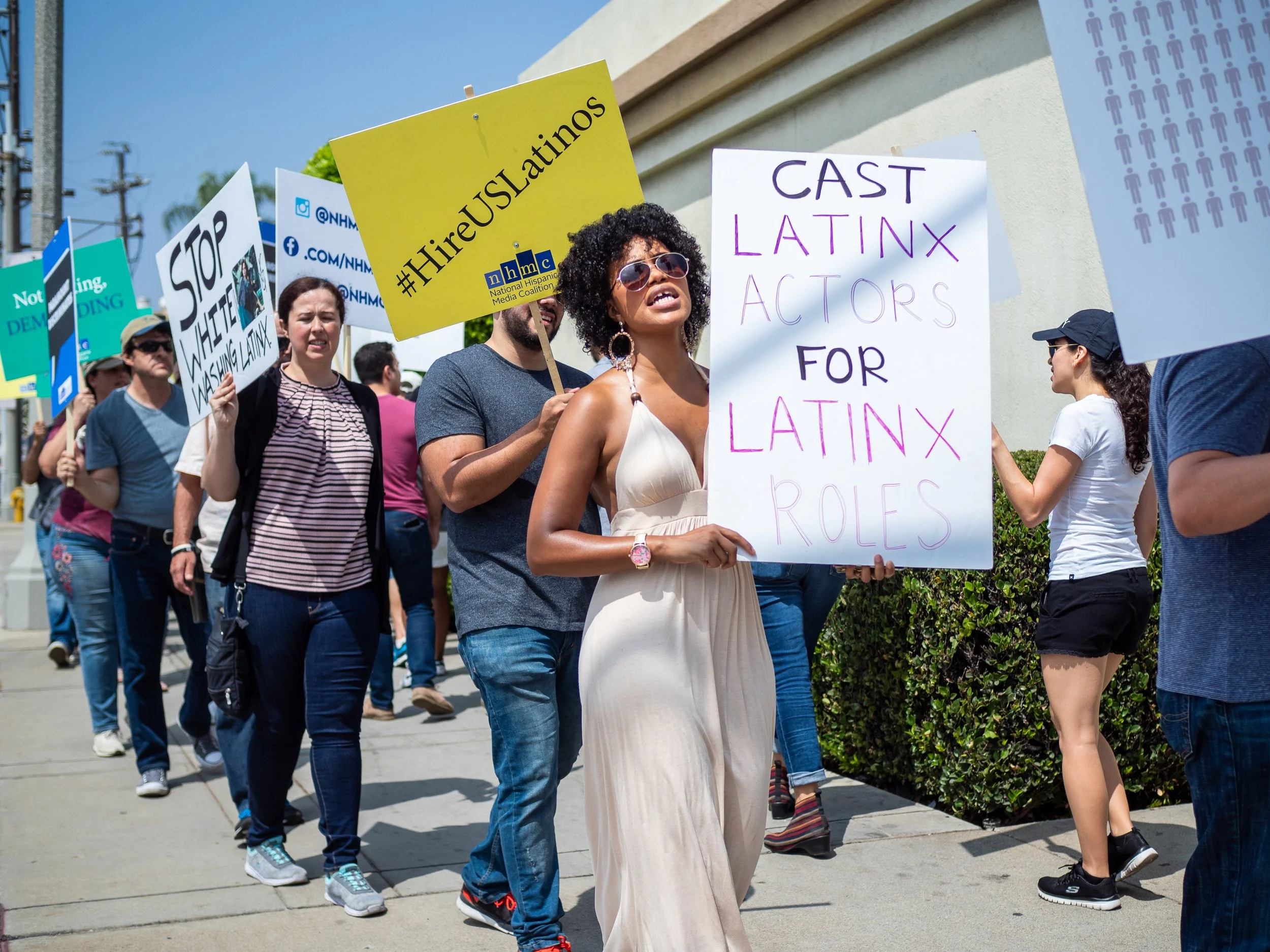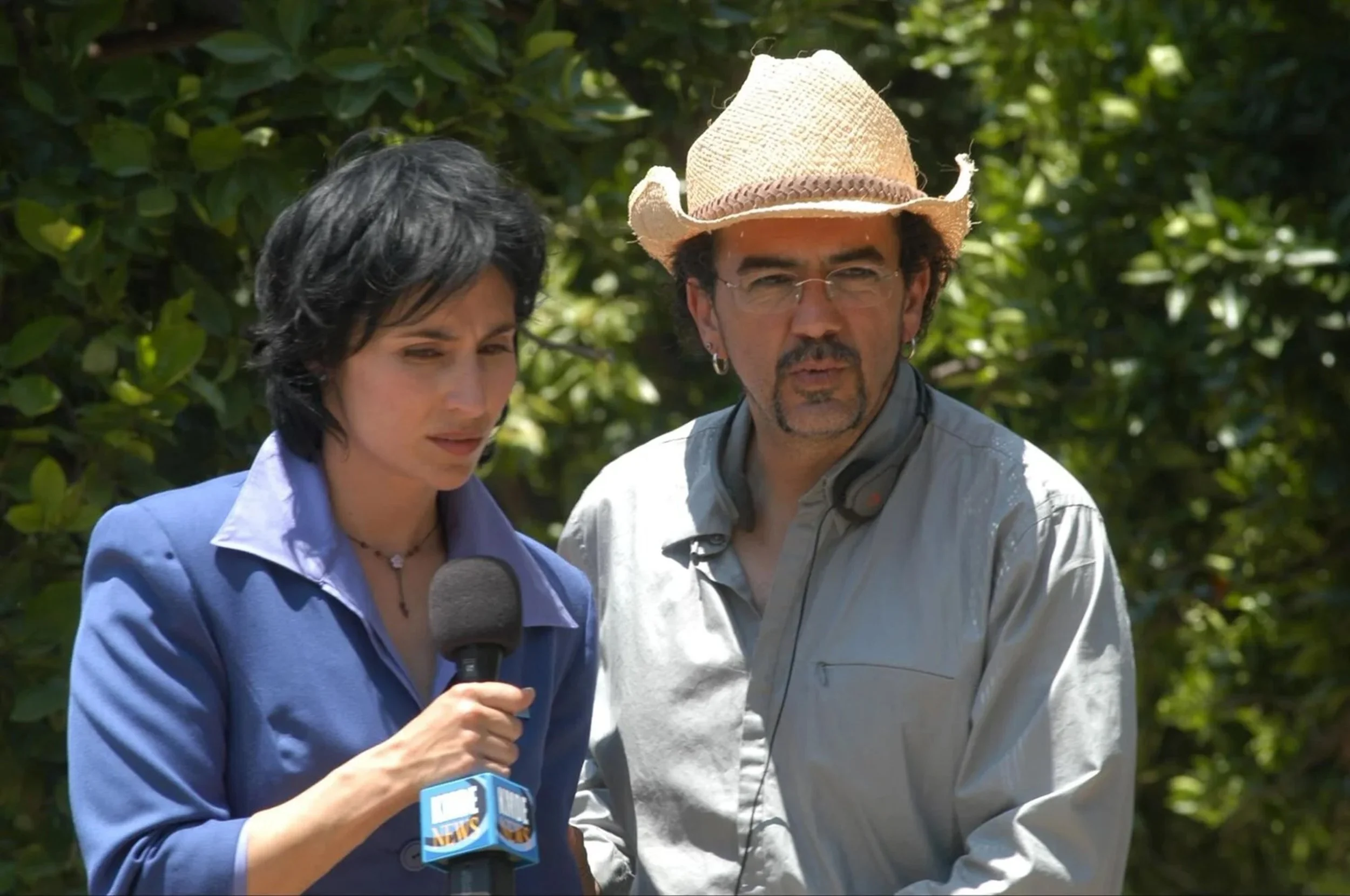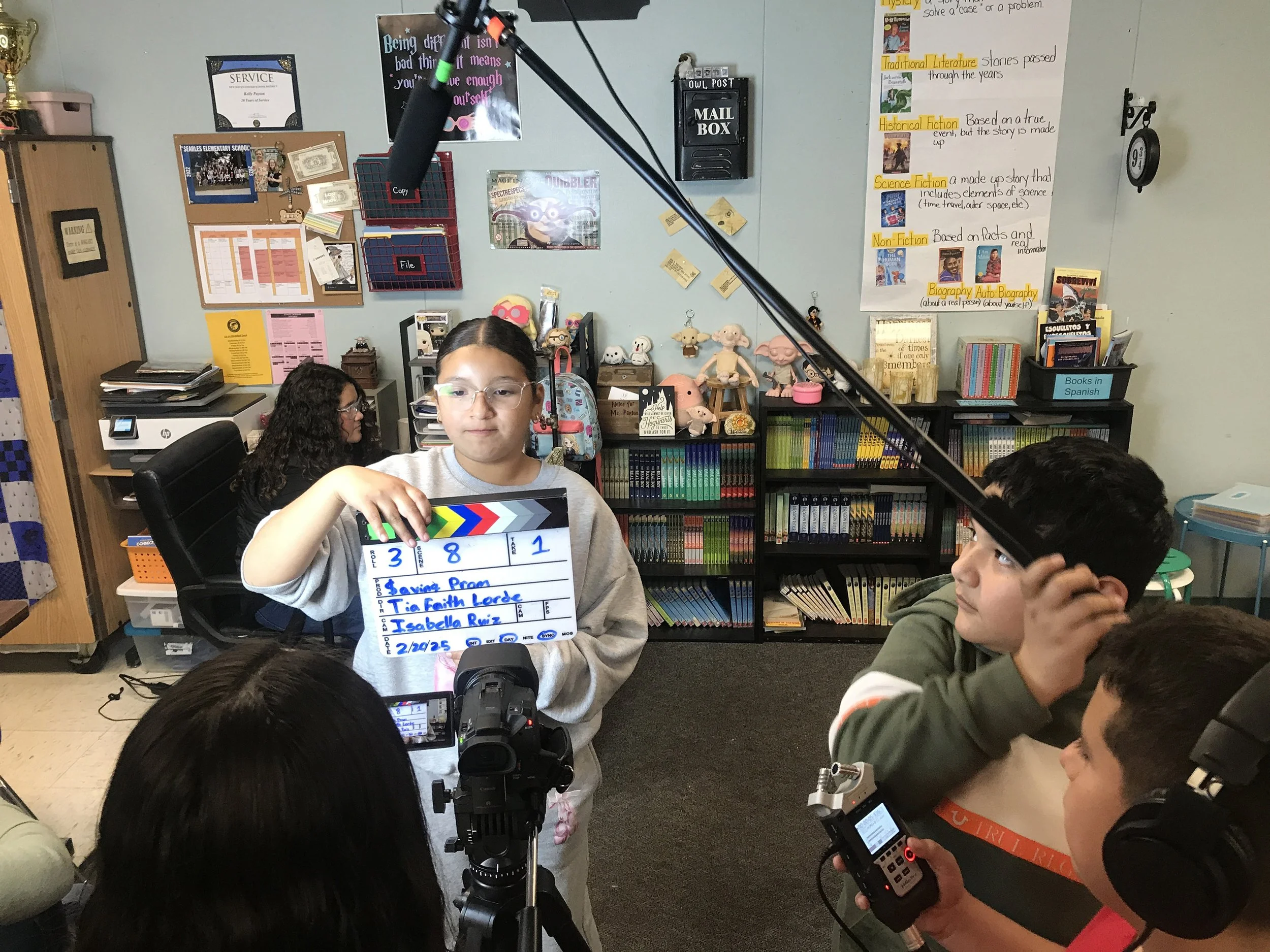Where Do Latinos Stand Now in Hollywood?
Photo illustration by Yunuen Bonaparte for palabra
From Jenna Ortega to Pedro Pascal, actors are breaking through as global stars, but industry insiders and researchers say real progress requires more behind the camera.
Haga clic aquí para leer este reportaje en español.
Pedro Pascal in The Last of Us; Diego Luna in Andor; Jenna Ortega in Wednesday; Liza Colón-Zayas in The Bear; John Leguizamo in Leguizamo Does America: these actors are among the most talked-about celebrities in the world today. Clearly their stars are shining brightly, but can they help light the way for the rest of Latino Hollywood?
Ask former movie studio publicist, and author of six books on the history of Hollywood Luis Reyes if he thinks Latino performers have been making progress in the entertainment industry, and he’ll answer without hesitation.
“There have been tremendous strides made in the last few years,” said Reyes, author of the Turner Classic Movies book Viva Hollywood: The Legacy of Latin and Hispanic Artists in American Film. “Every time I read the trades, there is always a new Latino or Latina name.”
Reyes, who worked for nearly all the major studios in his decades-long career, promoted countless films, including the iconic Stand and Deliver and Zoot Suit. He attributed the increased visibility of Latino actors, in part, to the rise of cable and streaming services. Unlike the old days when programming reached international audiences months, if not years later, these platforms allow worldwide audiences to quickly access content.
“Streaming is creating more opportunities for people. Not only Latinos, but Asians, the French, the Italians, whatever,” Reyes explained.
In the show “Leguizamo Does America,” John Leguizamo visits Miami and dives into Cuban coffee and conversations and explores the rich Latino influence that has made the city a cultural and economic powerhouse. Image courtesy of MSNBC
Sylvia Villagran is a bilingual voice-over actor in Hollywood, and in the past few years has become one of a select few to perform at the Emmys, Grammys, Oscars and Tony Awards. She said attitudes toward Latino creatives have greatly improved. Born and raised in California, she recalls a time when she “wasn’t even allowed” to audition for English-language voice-over spots because she was known as a Spanish-language actor.
“The casting directors wouldn’t see me for English-language (work). They would say, ‘We are not looking for an ethnic read or an urban read or an accented read.’ I was not able to compete,” Villagran said of her struggle for acceptance in Hollywood, where negative stereotypes often prevailed.
She said she believes her career finally took off when bilingual performers like Jennifer Lopez, Ricky Martin and Salma Hayek started becoming popular with the mainstream. Villagran recalls some industry decision-makers saying at the time: “So there are Latinos who speak both languages and are interesting and can compete in the (general) market!”
Sylvia Villagran backstage at the Oscars on March 12, 2023, when she became the ceremony's first Latina announcer. Photo courtesy of Sylvia Villagran
Recognition and Growth
Helen Hernandez, president and founder of the Imagen Foundation, has seen considerable change as well. She is also executive producer of the Imagen Awards, which was co-founded by legendary television producer Norman Lear in the 1980s. For 40 years, Hernandez and her team have held the Imagen Awards to honor outstanding achievement among Latinos in entertainment.
She said when the awards show first started, organizers had to scramble to find enough people to acknowledge at the event. Compare that to 2025, when the Imagen Awards received more than 400 entries.
“Have there been gains? Absolutely. There is no question,” Hernandez said.
Industry insiders say changes have not only been happening with big-budget film and network television productions. There are a growing number of Latinos in the independent sector, as well.
The Imagen Foundation’s 2025 Class of Influential Latinos in Media. The cohort includes individuals who are influential in providing the Latino community opportunities in the business, or the production of accurate depictions and stories of the Latino community. Photo courtesy of The Imagen Foundation
Diana Cadavid, director of industry programs for the Latino Film Institute, a nonprofit founded by actor Edward James Olmos, said she has seen improvements both in front of and behind the camera.
“I definitely see growth, and not only in representation in front of the camera,” Cadavid said. “I see an increase in the number of independent films made by Latino producers and directors. That means that Latinos get hired in all aspects of the industry.”
What the Data Says
Ana-Christina Ramón is the director of the Entertainment and Media Research Initiative at UCLA and is among the nation’s leading experts on diversity in entertainment. Along with Darnell Hunt, she co-authors the series of annual Hollywood Diversity Reports, which have examined for more than a decade the relationship between diversity and profits.
“You could see the trajectory starting around 2018 in terms of having more people of color (in films), and so it steadily rose,” said Ramón, who pointed out that there were very few Latinos in main casts when the research began.
“For Latinx actors, I would say the highest mark was in 2023. It followed along with other BIPOC (Black, Indigenous and People of Color) actors as well,” she explained.
Latino actors and media workers picket outside Paramount Pictures in Hollywood on Aug. 25, 2018, demanding better representation. Photo by Yunuen Bonaparte/NHMC
The 2024 report, which examined 2023, revealed that 4.7% of Latino performers were cast in lead roles, while 7.2% of total cast members in the top-grossing films were Latinos. Ramón said these figures are still low, considering Latinos make up about 19% of the U.S. population.
But the study released this year showed that Latino representation in top films “nosedived” in 2024, according to the most recent report. Only 1% of actors in leading roles and 3.6% of total cast members were identified as Latino.
Ramón attributed the decrease to production delays caused by the 2023 union strikes and less diverse casting in the independent films released in 2024.
It is also significant that the UCLA research found a 3.35% drop in domestic box office in that year.
“If you want to have a case study in terms of what rolling back diversity means, you just have to look at 2024,” Ramón said. “Rolling back diversity is not profitable.”
Will 2025 show gains? The numbers are not in yet, but Ramón says based on the casts of movies like The Fantastic Four: First Steps and Superman, there is a reasonable chance that 2025 will be a good year for Latino representation.
Latino creatives rally outside Paramount Pictures in Hollywood on Aug. 25, 2018, during a protest organized by the National Hispanic Media Coalition demanding better representation on screen and behind the camera. Photo by Yunuen Bonaparte/NHMC
Beyond Stereotypes
Observers may note that among the most significant changes in the way Hollywood views Latino actors nowadays is that they are being cast more often in roles not specifically written for Latinos.
Chilean-born actor Pedro Pascal has played characters with no specific ethnic identity in several projects. Other examples include Mexican-American actor Jay Hernandez, who portrays Thomas Magnum in the Magnum P.I. reboot, and Puerto Rican-born Ramón Rodríguez, who stars in Will Trent.
“They are just actors playing characters without regard to ethnicity,” Reyes said. “Which is basically what we’ve always wanted: to be considered for our talent.”
While all of this might be good news for actors, some behind-the-scenes creatives worry that progress is being measured primarily by who is in front of the camera, while the quality and quantity of Latino-centered stories remain limited.
“We weren’t doing well to begin with, so the fact that we are seeing more (Latino actors) is great,” said Rafael Agustín, a TV writer who worked on Jane the Virgin and authored the memoir Illegally Yours. “But I think this is a shift in Hollywood where they are turning away from our stories and have decided that diversity is going to be just in front of the cameras.”
‘We're showing them that there is someone who looks and sounds and feels like them, that is pursuing this career y que sí se puede.’
Agustín said that the COVID-19 pandemic, the strikes and global competition for movie production have resulted in the much-talked-about shrinking of the entertainment industry. As he sees it, these are among the factors that could make Hollywood less willing to take risks.
“They are only going for sure hits,” Agustín said. “And all the other stories that we think are special and unique—they are not going to be doing any time soon.”
Yareli Arizmendi, an actress, writer and producer best known for the films Como agua para chocolate (Like Water for Chocolate) and A Day Without a Mexican, celebrated the fact that Latinos are being seen more often in blockbuster films and award-winning shows. But she noted that these top stars are frequently cast in science fiction or horror genres, projects she described as “extraordinary realities.”
“It’s interesting that it’s (mostly) science fiction that propels us,” Arizmendi said. “We’re fine in the future. We’re not fine in the present. Not now, not here.”
Arizmendi added that she longs for more stories that depict the hopes, dreams and challenges of Latinos living everyday lives.
Yareli Arizmendi plays a reporter on the set of “A Day Without A Mexican” with director Sergio Arau. Photo courtesy of Yareli Arizmendi
Voice actor Villagran said she would like to see more authentic stories about the community, and greater support and cooperation within Latino Hollywood.
“I just wish that we would bring in the creators, the producers, the directors,” Villagran said. “Create a pipeline for us so as to give other Latinos opportunities.”
One of the organizations dedicated to creating connections for the next generation is the Latino Film Institute’s Youth Cinema Project (YCP). Students from select public schools in underrepresented communities, mostly in California, participate in a filmmaking program taught by experienced professionals for the school year.
‘It is important for everyone to be part of the solution.’
“We're showing them that there is someone who looks and sounds and feels like them, that is pursuing this career y que sí se puede,” said Hector Chaira, YCP’s director of education programs.
“It is important for everyone to be part of the solution,” Hernandez, from the Imagen Foundation, said. Her organization holds an event every spring honoring Latino executives in mainstream media.
Hernandez said she is certain that having more Latinos in the C-suites is the key that will open doors and keep them open.
“When the decision-makers are in the room that understand our community and understand the issues we care about, that’s when significant change will be made,” Hernandez said.
Youth Cinema Project (YCP) students from New Haven Unified School District work behind the scenes on their short film. Photo courtesy of Latino Film Institute
The Road Ahead
Interviewees agreed that increasing Latino representation in all aspects of entertainment will take a combination of efforts–from advocacy on the part of organizations, politicians and performers, to moviegoers who support Latino-themed projects by buying tickets, writing reviews and posting on social media.
For historian Reyes though, it begins with actors who achieve stardom and can all but guarantee big profits at the box office.
Support the voices of independent journalists.
|
“We have to develop our stars,” Reyes said. “Pedro Pascal (for example), if he continues the way he is going, will have the power to get projects (made) that reflect the American Latino experience—if that’s what he wants to do.”
Others believe that higher visibility and name recognition also set the stage for stronger audience bonds with a performer. These connections can create a level of comfort and familiarity that not only benefits the actor’s career, but also has residual value.
“One of the reasons I see this as progress has nothing to do with what the actors do on camera,” Arizmendi said. “It’s because they get interviewed and they become people who can speak out about other things. We get to know them as human beings.”
—
Saida Rodríguez Pagán is a Los Angeles-based journalist celebrating her fifth year as a contributor with palabra. Since 2020, Saida’s articles on the entertainment industry — and her television reports and documentaries — have been nominated for 22 Los Angeles Press Club-sponsored awards, Golden Mike Awards, Emmy Awards, or National Association of Telecommunications Officers and Advisors regional and national awards. Saida was born and raised in New York City and is of Puerto Rican ancestry. She earned a master’s degree with distinction in Strategic Communication from National University, a B.A. in Communication from the City University of New York, and, in September 2024, received a certificate with highest honors in Journalism and News Writing from The New York University School of Professional Studies. Her show, “American Stories with Saida Pagan,” can be seen on YouTube and the Arroyo Channel in Southern California, as well as on various streaming platforms. @SaidaPagan
Rodrigo Cervantes is an award-winning bilingual journalist and communications strategist with extensive experience in the U.S., Mexico, and internationally. He has contributed to outlets such as NPR, CNN, The Los Angeles Times, and the BBC. Cervantes led KJZZ’s Mexico City bureau, where he launched the first overseas bureau for a U.S. public radio station. He also served as Business Editor-in-Chief for El Norte, part of Grupo Reforma, Mexico’s leading newspaper company. In Georgia, he led the newsroom of MundoHispánico, then the state’s oldest and largest Latino publication, under The Atlanta Journal-Constitution. His work has been recognized with RTDNA Murrow Awards and José Martí Awards from the National Association of Hispanic Publications (NAHP). He is the former Secretary of the National Association of Hispanic Journalists (NAHJ) and currently serves as co-managing editor of palabra, and as a clinical assistant professor at Arizona State University’s W. Cronkite School of Journalism and Mass Communication. @RODCERVANTES

